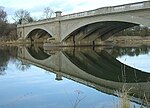Shelford Priory
1160s establishments in England1536 disestablishments in EnglandAugustinian monasteries in EnglandChristian monasteries established in the 12th centuryGrade II* listed buildings in Nottinghamshire ... and 3 more
Monasteries in NottinghamshireStanhope familyUse British English from January 2014

Shelford Priory is a former Augustinian Monastery located in the village of Shelford, Nottinghamshire, United Kingdom. The priory was founded by Ralph Haunselyn around 1160–80 and dissolved in 1536. Little remains of the original priory. Following dissolution it was granted to Michael Stanhope, and c.1600 Shelford Manor was constructed on the site. The manor was fortified and then partially destroyed during the English Civil War. The house was reconstructed c.1678, however, it was altered in the 18th and 19th centuries. It is now known as Shelford Manor and is a private residence.
Excerpt from the Wikipedia article Shelford Priory (License: CC BY-SA 3.0, Authors, Images).Shelford Priory
Rushcliffe
Geographical coordinates (GPS) Address Nearby Places Show on map
Geographical coordinates (GPS)
| Latitude | Longitude |
|---|---|
| N 52.9841 ° | E -1 ° |
Address
NG12 1ER Rushcliffe
England, United Kingdom
Open on Google Maps







